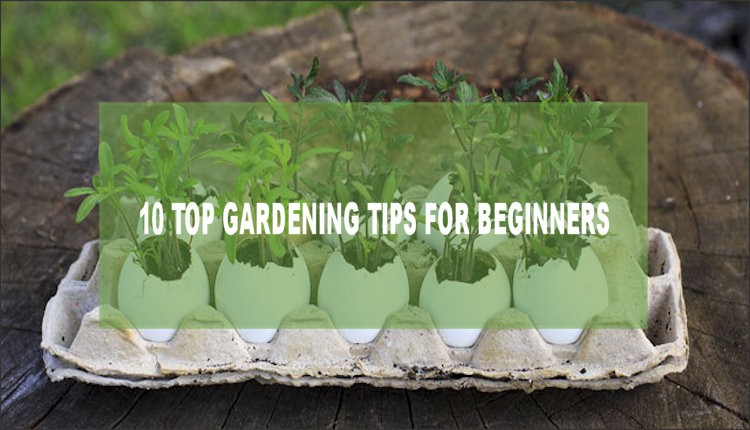
Top 10 Gardening Tips
Find out the most important ten things you need to know to garden successfully for either garden plants or food produce.
10 Top Gardening Tips for Beginners
Wondering how to start a garden and looking for some simple expert gardening tips
Whether you are experienced or new to gardening, make your grow-your-own dreams a reality with these 10 easy-to-follow tips.
1. Site Location Is Important
Starting a garden is just like real estate it’s all about location, it’s important so placing your garden is important where you’ll see it regularly (out of sight, out of mind definitely applies to gardening) – that way, you’ll be much more likely to spend time in it.
2. Follow The Sun
Misjudging sunlight is a common pitfall when you’re first learning to garden so pay attention to how sunlight plays across your desired planting location before choosing a spot for your garden. Most edible plants, including many vegetables, herbs, and fruits, need at least 6 hours of sun in order to thrive.
3. Have Access To Water
One of the best gardening tips you’ll ever get is to plan your new gardening project that has a close water source so make sure you can run a water hose to your growing site. The last thing you’ll be wanting to do is to lug water each time your plants get thirsty.
The best way to tell if plants need watering is to push a finger an inch down into the soil (that’s about one knuckle deep) – if it’s dry, it’s time to water.
4. Begin With The Best Soil
When starting a garden, one of the top pieces of advice is to invest in soil that is nutrient-rich and well-drained so to achieve this, blend your soil by mixing 3 inches of quality all-purpose mix into the top 6 to 8 inches of existing soil if you’re planning to plant in the ground.
If you’re planting in a raised bed, use the same mix, which is the perfect weight and texture for raised bed growing.
5. Consider Planting Containers
When space is at a premium, such as small flats, look to using containers – you can use virtually anything in them, including vegetables, herbs, flowers, fruit trees, berries, and shrubs.
When gardening in containers, use a pot that’s large enough for the plant it’s hosting, and fill it with a quality all-purpose soil mix. Not only is it specially formulated to help plants in pots thrive, but it also helps protect against over-and-under-watering.
6. Choose The Right Plants
It’s important to select plants that match your growing conditions which means putting sun-loving plants into a sunny spot, choosing heat-tolerant plants in warm climates, and giving ground-gobbling vines like pumpkins and melons ample elbow room or a trellis to climb.
Do your homework and pick varieties that will grow well where you live, space you have, and to get a step up on success when growing veggies and herbs, start with vigorous young plants from quality plant suppliers instead of trying to grow from seed.
7. Discover Your ZEN
Knowing your “hardiness zones” in your newly established garden can help you choose the best plants. Simply put, it describes the coldest place a plant can grow so the higher the zone number, the warmer the climate.
So if a plant is “hardy to zone 4” and you garden in zone 5, that plant will be hardy and survive. If, however, you’re in zone 3, it’s too cold to grow that particular plant, again, reach out to the experts who will more than happy to advise which are the best plants for your garden.
8. Learn Your Frost Dates
Planting too early (or late) in the season can spell disaster for your newly established garden as you need to know the last average spring frost date for your area so you don’t accidentally kill plants by putting them out prematurely.
It’s also good to know your first average autumn frost date so that you get your plants harvested or moved indoors before late-season cold damages them. Again, ask for help from plant suppliers who are experts in this field.
9. Go On, Add Some Mulch!
Apply a layer of nutrient-rich mulch that’s 2 to 3 inches deep around each plant as this will help reduce weeds by blocking out the sun, and reduce moisture loss through evaporation, so you’ll have to be waterless.
For a polished look, put down a layer of quality bagged mulch, or, you can put down straw, shredded leaves, pine straw, or some other locally available material.
10. Feed Your Plants Regularly
We’ve already talked about the importance of starting with great soil, but that soil works best in concert with regular boosts of high-quality nutrition for your plants. In other words, amazing soil + top-notch plant food = super garden success! So, a month after planting, begin feeding your garden with quality plant food and a good water-soluble all-purpose plant food, so be sure to follow those all-important label directions.
One last bit of advice, be sure to stock up on the basic tools you need to make it easier to grow your garden. Remember, we have a dedicated garden section where you can get all your needs such as plants, mulch, and tools to get you off to the right start!
So there you have it, a simple, easy-peasy way to refill your ink cartridges, save a ton of money at the same time and save the environment from single-use plastic waste!
NEWSLETTER
Be sure to subscribe to our periodical newsletter so whenever we have any garden-related news or advertisers, you’ll be the first to know!


